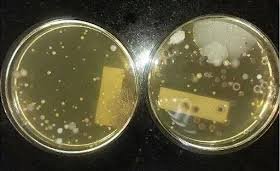How to Eliminate Microbial Contamination from Classified Area

Elimination of Microbial Contamination from Classified Areas
1. Root Cause Identification
Before elimination, identify why contamination occurred:
-
Breach in personnel gowning or behavior.
-
Ineffective cleaning/sanitization.
-
HEPA filter leakage or improper airflow.
-
Uncontrolled material movement.
-
Defective pass boxes or transfer procedures.
-
High particle load from adjacent areas.
-
Stagnant water or condensation in the area.
2. Immediate Containment Actions
-
Stop aseptic operations in the affected area.
-
Quarantine materials, equipment, and in-process batches.
-
Inform QA and initiate deviation/CAPA.
-
Increase environmental monitoring frequency.
3. Elimination & Remediation Steps
-
Deep Cleaning & Sanitization
-
Perform thorough cleaning using validated disinfectants (e.g., quaternary ammonium, hydrogen peroxide, isopropyl alcohol).
-
Alternate disinfectants to prevent resistance.
-
Apply sporicidal agents (e.g., peracetic acid, chlorine dioxide) if spore-formers are suspected.
-
-
HEPA Filter & HVAC Checks
-
Perform smoke studies/airflow visualization to confirm laminarity.
-
Conduct HEPA integrity testing (DOP/PAO).
-
Check differential pressures between rooms.
-
-
Personnel Control
-
Retrain operators on aseptic techniques and gowning.
-
Verify gowning integrity (glove, mask, hood checks).
-
Requalify personnel if repeated failures occur.
-
-
Material & Equipment Control
-
Review transfer procedures (via pass boxes, airlocks).
-
Ensure all materials are disinfected/sterilized before entry.
-
Use dedicated, cleanroom-graded equipment only.
-
-
Environmental Decontamination
-
Perform fumigation or VHP (Vaporized Hydrogen Peroxide) cycle for high contamination cases.
-
Use UV light exposure in pass boxes and airlocks as supportive measure.
-
-
Water System & Utilities Check
-
Test purified water and compressed air lines used in the area.
-
Eliminate stagnant points or leaks that may harbor microbes.
-
4. Verification of Effectiveness
-
Perform follow-up environmental monitoring (air, surface, glove prints).
-
Compare results against alert/action limits.
-
Document trend analysis to ensure contamination is eliminated.
5. Preventive Measures (CAPA)
-
Establish robust cleaning & sanitization schedule.
-
Rotate disinfectants periodically.
-
Conduct routine HVAC and HEPA filter maintenance.
-
Enforce strict gowning discipline and personnel monitoring.
-
Review and revalidate classified areas periodically (smoke study, recovery test).
-
Implement a contamination control strategy per Annex 1 (EU GMP).
✅ In short:
To eliminate microbial contamination from classified areas, identify the root cause, perform deep cleaning with validated disinfectants, check HVAC/HEPA systems, retrain personnel, and verify effectiveness through enhanced environmental monitoring. Long-term prevention requires a strong contamination control strategy.
🎓 Discover one of the best Pharmaceutical Microbiology course available —click below to explore the course that’s shaping future Microbiology course skills.

